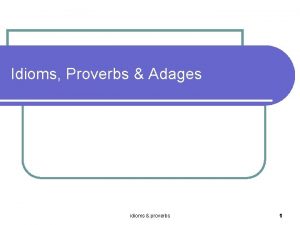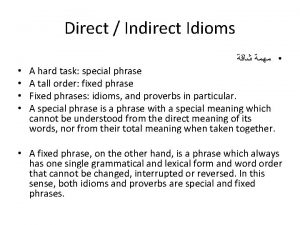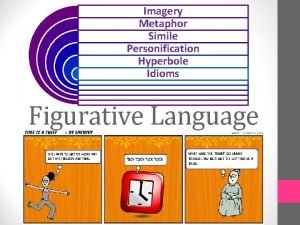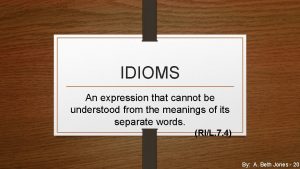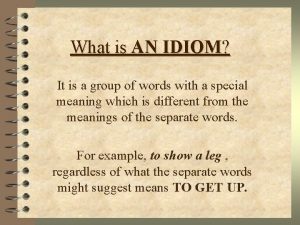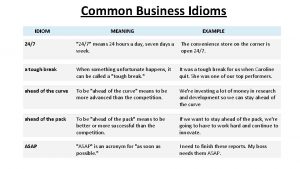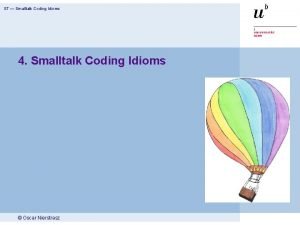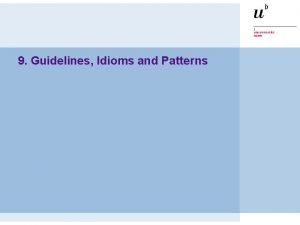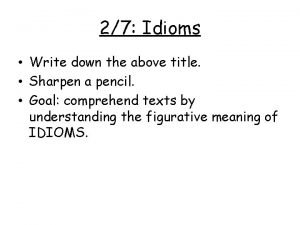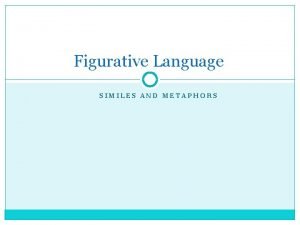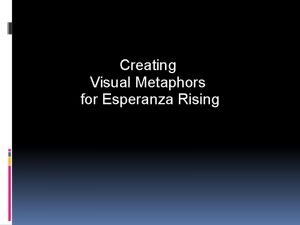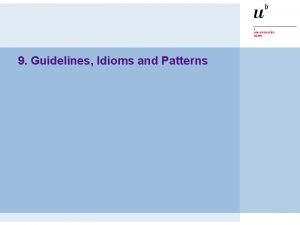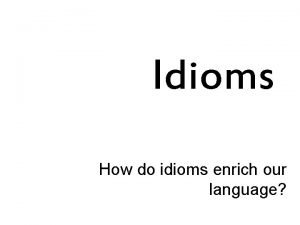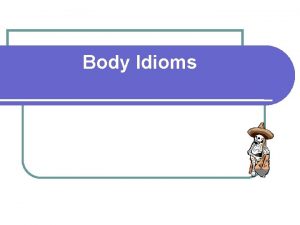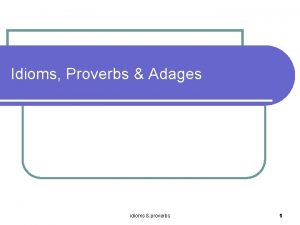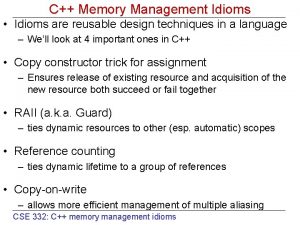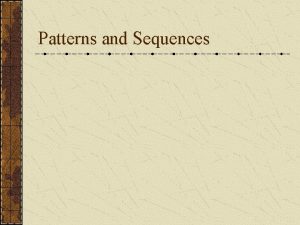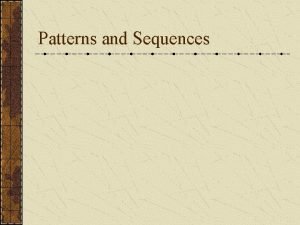9 Guidelines Idioms and Patterns P 2 Guidelines
















































- Slides: 48

9. Guidelines, Idioms and Patterns

P 2 — Guidelines, Idioms and Patterns Roadmap > Idioms, Patterns and Frameworks — Programming style: Code Talks; Code Smells > Basic Idioms — Delegation, Super, Interface > Some Design Patterns — Adapter, Proxy, Template Method, Composite, Observer, Visitor, State © O. Nierstrasz 9. 2

P 2 — Guidelines, Idioms and Patterns Roadmap > Idioms, Patterns and Frameworks — Programming style: Code Talks; Code Smells > Basic Idioms — Delegation, Super, Interface > Some Design Patterns — Adapter, Proxy, Template Method, Composite, Observer, Visitor, State © O. Nierstrasz 9. 3

P 2 — Guidelines, Idioms and Patterns Sources Erich Gamma, Richard Helm, Ralph Johnson and John Vlissides, Design Patterns, Addison Wesley, Reading, MA, 1995. Frank Buschmann, et al. , Pattern-Oriented Software Architecture — A System of Patterns, Wiley, 1996 Mark Grand, Patterns in Java, Volume 1, Wiley, 1998 Kent Beck, Smalltalk Best Practice Patterns, Prentice Hall, 1997 “Code Smells”, http: //c 2. com/cgi/wiki? Code. Smell or http: //sis 36. berkeley. edu/projects/streek/agile/bad-smells-in-code. html © O. Nierstrasz 9. 4

P 2 — Guidelines, Idioms and Patterns Style Code Talks > Do the simplest thing you can think of (KISS) — Don't over-design — Implement things once and only once — First do it, then do it right, then do it fast (don’t optimize too early) > Make your intention clear — — Write small methods Each method should do one thing only Name methods for what they do, not how they do it Write to an interface, not an implementation © O. Nierstrasz 9. 5

P 2 — Guidelines, Idioms and Patterns Refactoring Redesign and refactor when the code starts to “smell” Code Smells (http: //sis 36. berkeley. edu/projects/streek/agile/bad-smells-in-code. html) > Methods too long or too complex — decompose using helper methods > Duplicated code — factor out the common parts (e. g. , using a Template method Pattern) > Violation of encapsulation — redistribute responsibilities > Too much communication (high coupling) — redistribute responsibilities Many idioms and patterns can help you improve your design. . . © O. Nierstrasz 9. 6

P 2 — Guidelines, Idioms and Patterns Refactoring Long Methods short is good! If I need to comment then extract as method © O. Nierstrasz 9. 7

P 2 — Guidelines, Idioms and Patterns What are Idioms and Patterns? Idioms are common programming techniques and conventions. They are often language-specific. (http: //c 2. com/ppr/wiki/Java. Idioms. html) Patterns document common solutions to design problems. They are language-independent. Libraries are collections of functions, procedures or other software components that can be used in many applications. Frameworks are open libraries that define the generic architecture of an application, and can be extended by adding or deriving new classes. (http: //martinfowler. com/bliki/Inversion. Of. Control. html) Frameworks typically make use of common idioms and patterns. © O. Nierstrasz 9. 8

P 2 — Guidelines, Idioms and Patterns Roadmap > Idioms, Patterns and Frameworks — Programming style: Code Talks; Code Smells > Basic Idioms — Delegation, Super, Interface > Some Design Patterns — Adapter, Proxy, Template Method, Composite, Observer, Visitor, State © O. Nierstrasz 9. 9

P 2 — Guidelines, Idioms and Patterns Delegation How can an object share behaviour without inheritance? Delegate some of its work to another object Inheritance is a common way to extend the behaviour of a class, but can be an inappropriate way to combine features. Delegation reinforces encapsulation by keeping roles and responsibilities distinct. © O. Nierstrasz 9. 10

P 2 — Guidelines, Idioms and Patterns Delegation Example > When a Test. Suite is asked to run(), it delegates the work to each of its Test. Cases. Consequences > More flexible, less structured than inheritance. Delegation is one of the most basic object-oriented idioms, and is used by almost all design patterns. © O. Nierstrasz 9. 11

P 2 — Guidelines, Idioms and Patterns Delegation example public class Test. Suite implements Test {. . . public void run(Test. Result result) { for(Enumeration e = f. Tests. elements(); e. has. More. Elements(); ) { if (result. should. Stop()) break; delegate Test test = (Test) e. next. Element(); test. run(result); } } } © O. Nierstrasz 9. 12

P 2 — Guidelines, Idioms and Patterns Super How do you extend behavior inherited from a superclass? Overwrite the inherited method, and send a message to “super” in the new method. Sometimes you just want to extend inherited behavior, rather than replace it. © O. Nierstrasz 9. 13

P 2 — Guidelines, Idioms and Patterns Super Examples > Place. paint() extends Panel. paint() with specific painting behaviour > Constructors for many classes, e. g. , Tic. Tac. Toe, invoke their superclass constructors. Consequences > Increases coupling between subclass and superclass: if you change the inheritance structure, super calls may break! Never use super to invoke a method different than the one being overwritten — use “this” instead! © O. Nierstrasz 9. 14

P 2 — Guidelines, Idioms and Patterns Super examples public class Place extends Panel {. . . public void paint(Graphics g) { super. paint(g); Rectangle rect = g. get. Clip. Bounds(); int h = rect. height; int w = rect. width; int offset = w/10; g. draw. Rect(0, 0, w, h); if (image != null) { g. draw. Image(image, offset, w-2*offset, h-2*offset, this); } }. . . public class Tic. Tac. Toe extends Abstract. Board. Game { public Tic. Tac. Toe(Player player. X, Player player. O) { super(player. X, player. O); } © O. Nierstrasz 9. 15

P 2 — Guidelines, Idioms and Patterns Interface How do you keep a client of a service independent of classes that provide the service? Have the client use the service through an interface rather than a concrete class. If a client names a concrete class as a service provider, then only instances of that class or its subclasses can be used in future. By naming an interface, an instance of any class that implements the interface can be used to provide the service. © O. Nierstrasz 9. 16

P 2 — Guidelines, Idioms and Patterns Interface Example > Any object may be registered with an Observable if it implements the Observer interface. > Consequences > Interfaces reduce coupling between classes. > They also increase complexity by adding indirection. © O. Nierstrasz 9. 17

P 2 — Guidelines, Idioms and Patterns Interface example public class Game. GUI extends JFrame implements Observer { … public void update(Observable o, Object arg) { Move move = (Move) arg; show. Feed. Back("got an update: " + move); places_[move. col][move. row]. set. Move(move. player); } … } © O. Nierstrasz 9. 18

P 2 — Guidelines, Idioms and Patterns Roadmap > Idioms, Patterns and Frameworks — Programming style: Code Talks; Code Smells > Basic Idioms — Delegation, Super, Interface > Some Design Patterns — Adapter, Proxy, Template Method, Composite, Observer, Visitor, State © O. Nierstrasz 9. 19

P 2 — Guidelines, Idioms and Patterns Adapter Pattern How do you use a class that provide the right features but the wrong interface? Introduce an adapter. An adapter converts the interface of a class into another interface clients expect. > The client and the adapted object remain independent. > An adapter adds an extra level of indirection. Also known as Wrapper © O. Nierstrasz 9. 20

P 2 — Guidelines, Idioms and Patterns Adapter Pattern Examples > A Wrapped. Stack adapts java. util. Stack, throwing an Assertion. Exception when top() or pop() are called on an empty stack. > An Action. Listener converts a call to action. Performed() to the desired handler method. > Consequences > The client and the adapted object remain independent. > An adapter adds an extra level of indirection. © O. Nierstrasz 9. 21

P 2 — Guidelines, Idioms and Patterns Adapter Pattern example public class Wrapped. Stack implements Stack. Interface { private java. util. Stack stack; public Wrapped. Stack() { this(new Stack()); } public Wrapped. Stack(Stack stack) { this. stack = stack; } delegate request to adaptee public void push(Object item) { stack. push(item); assert this. top() == item; assert invariant(); } © O. Nierstrasz 9. 22

P 2 — Guidelines, Idioms and Patterns Proxy Pattern How do you hide the complexity of accessing objects that require pre- or post-processing? Introduce a proxy to control access to the object. Some services require special pre or post-processing. Examples include objects that reside on a remote machine, and those with security restrictions. A proxy provides the same interface as the object that it controls access to. © O. Nierstrasz 9. 23

P 2 — Guidelines, Idioms and Patterns Proxy Pattern - UML «interface» Client Proxy © O. Nierstrasz Subject delegate Real. Subject 9. 24

P 2 — Guidelines, Idioms and Patterns Proxy Pattern Example (1) package proxy. Pattern; public interface Image { public void display. Image(); } «interface» Client Proxy. Image © O. Nierstrasz Image delegate Real. Image 9. 25

P 2 — Guidelines, Idioms and Patterns Proxy Pattern Example (2) public class Proxy. Image implements Image { private String filename; private Image image; delegate request to real subject public Proxy. Image(String filename){ this. filename = filename; } public void display. Image() { if (image == null) { image = new Real. Image(filename); //load only on demand } image. display. Image(); } } © O. Nierstrasz 9. 26

P 2 — Guidelines, Idioms and Patterns Proxy Pattern Example (3) public class Real. Image implements Image { private String filename; public Real. Image(String filename) { this. filename = filename; System. out. println("Loading "+filename); } public void display. Image() { System. out. println("Displaying "+filename); } } © O. Nierstrasz 9. 27

P 2 — Guidelines, Idioms and Patterns Proxy Pattern Example (4) - the Client public class Proxy. Example { public static void main(String[] args) { Array. List<Image> images = new Array. List<Image>(); images. add(new Proxy. Image("Hi. Res_10 MB_Photo 1")); images. add(new Proxy. Image("Hi. Res_10 MB_Photo 2")); images. add(new Proxy. Image("Hi. Res_10 MB_Photo 3")); images. get(0). display. Image(); images. get(1). display. Image(); images. get(0). display. Image(); // already loaded } } © O. Nierstrasz 9. 28

P 2 — Guidelines, Idioms and Patterns Proxies are used for remote object access Example > A Java “stub” for a remote object accessed by Remote Method Invocation (RMI). Consequences > A Proxy decouples clients from servers. A Proxy introduces a level of indirection. Proxy differs from Adapter in that it does not change the object’s interface. © O. Nierstrasz 9. 29

P 2 — Guidelines, Idioms and Patterns Proxy remote access example © O. Nierstrasz 9. 30

P 2 — Guidelines, Idioms and Patterns Template Method Pattern How do you implement a generic algorithm, deferring some parts to subclasses? Define it as a Template Method. A Template Method factors out the common part of similar algorithms, and delegates the rest to: — hook methods that subclasses may extend, and — abstract methods that subclasses must implement. © O. Nierstrasz 9. 31

P 2 — Guidelines, Idioms and Patterns Template Method Pattern (2) Example > Test. Case. run. Bare() is a template method that calls the hook method set. Up(). > Abstract. Board. Game’s constructor defers initialization to the abstract init() method Consequences > Template methods lead to an inverted control structure since a parent classes calls the operations of a subclass and not the other way around. Template Method is used in most frameworks to allow application programmers to easily extend the functionality of framework classes. © O. Nierstrasz 9. 32

P 2 — Guidelines, Idioms and Patterns Template Method Pattern - UML Hook methods Abstract. Class primitive. Operation() … template. Method() Defines the skeleton of the algorithm Concrete. Class 1 Concrete. Class 2 primitive. Operation() … primitive. Operation(). . © O. Nierstrasz Overrides the base class methods 9. 33

P 2 — Guidelines, Idioms and Patterns Template Method Pattern Example Subclasses of Test. Case are expected to override hook method set. Up() and possibly tear. Down() and run. Test(). public abstract class Test. Case implements Test {. . . public void run. Bare() throws Throwable { set. Up(); try { run. Test(); } finally { tear. Down(); } } protected void set. Up() { } // empty by default protected void tear. Down() { } protected void run. Test() throws Throwable {. . . } } © O. Nierstrasz 9. 34

P 2 — Guidelines, Idioms and Patterns Composite Pattern How do you manage a part-whole hierarchy of objects in a consistent way? Define a common interface that both parts and composites implement. Typically composite objects will implement their behavior by delegating to their parts. © O. Nierstrasz 9. 35

P 2 — Guidelines, Idioms and Patterns Composite Pattern Example > Composite allows you to treat a single instance of an object the same way as a group of objects. > Consider a Tree. It consists of Trees (subtrees) and Leaf objects. Leaf Tree © O. Nierstrasz 9. 36

P 2 — Guidelines, Idioms and Patterns Composite Pattern Example (2) «interface» Icomponent add. Component() remove. Component() get. Children() Leaf public interface IComponent { Collection get. Children(); boolean add. Component(IComponent c); boolean remove. Component(IComponent c); } +children Composite public class Leaf implements IComponent { Collection get. Children(){ return null; } boolean add. Component(IComponent c){ return false; } boolean remove. Component(IComponent c) { return false; } } © O. Nierstrasz 9. 37

P 2 — Guidelines, Idioms and Patterns Composite Pattern Example (3) public class Composite implements IComponent { private String id; private Array. List<IComponent> list = new Array. List<IComponent> (); public boolean add. Component(IComponent c) { return list. add(c); } public Collection get. Children() { return list; } public boolean remove. Component(IComponent c) { return list. remove(c); } …� } © O. Nierstrasz 9. 38

P 2 — Guidelines, Idioms and Patterns Composite Pattern Example — Client Usage (4) public class Composite. Client { public static void main(String[] args) { Composite switzerland = new Composite("Switzerland"); Leaf bern = new Leaf("Bern"); Leaf zuerich = new Leaf("Zuerich"); switzerland. add. Component(bern); switzerland. add. Component(zuerich); Composite europe = new Composite("Europe"); europe. add. Component(switzerland); System. out. println(europe. to. String()); } } © O. Nierstrasz 9. 39

P 2 — Guidelines, Idioms and Patterns Observer Pattern How can an object inform arbitrary clients when it changes state? Clients implement a common Observer interface and register with the “observable” object; the object notifies its observers when it changes state. An observable object publishes state change events to its subscribers, who must implement a common interface for receiving notification. © O. Nierstrasz 9. 40

P 2 — Guidelines, Idioms and Patterns Observer Pattern (2) Example > See GUI Lecture > A Button expects its observers to implement the Action. Listener interface. (see the Interface and Adapter examples) Consequences > Notification can be slow if there are many observers for an observable, or if observers are themselves observable! © O. Nierstrasz 9. 41

P 2 — Guidelines, Idioms and Patterns Null Object Pattern How do you avoid cluttering your code with tests for null object pointers? Introduce a Null Object that implements the interface you expect, but does nothing. Null Objects may also be Singleton objects, since you never need more than one instance. © O. Nierstrasz 9. 42

P 2 — Guidelines, Idioms and Patterns Null Object Pattern — UML Client Abstract. Object uses request() © O. Nierstrasz Real. Object Null. Object request() 9. 43

P 2 — Guidelines, Idioms and Patterns Null Object Examples > Null. Output. Stream extends Output. Stream with an empty write() method Consequences > Simplifies client code > Not worthwhile if there are only few and localized tests for null pointers © O. Nierstrasz 9. 44

P 2 — Guidelines, Idioms and Patterns What Problems do Design Patterns Solve? Patterns: > document design experience > enable widespread reuse of software architecture > improve communication within and across software development teams > explicitly capture knowledge that experienced developers already understand implicitly > arise from practical experience > help ease the transition to object-oriented technology > facilitate training of new developers > help to transcend “programming language-centric” viewpoints Doug Schmidt, CACM Oct 1995 © O. Nierstrasz 9. 45

P 2 — Guidelines, Idioms and Patterns What you should know! What’s wrong with long methods? How long should a method be? What’s the difference between a pattern and an idiom? When should you use delegation instead of inheritance? When should you call “super”? How does a Proxy differ from an Adapter? How can a Template Method help to eliminate duplicated code? When do I use a Composite Pattern? Do you know any examples from the Frameworks you know? © O. Nierstrasz 9. 46

P 2 — Guidelines, Idioms and Patterns Can you answer these questions? What idioms do you regularly use when you program? What patterns do you use? What is the difference between an interface and an abstract class? When should you use an Adapter instead of modifying the interface that doesn’t fit? Is it good or bad that java. awt. Component is an abstract class and not an interface? Why do the Java libraries use different interfaces for the Observer pattern (java. util. Observer, java. awt. event. Action. Listener etc. )? © O. Nierstrasz 9. 47

Safety Patterns License http: //creativecommons. org/licenses/by-sa/2. 5/ Attribution-Share. Alike 2. 5 You are free: • to copy, distribute, display, and perform the work • to make derivative works • to make commercial use of the work Under the following conditions: Attribution. You must attribute the work in the manner specified by the author or licensor. Share Alike. If you alter, transform, or build upon this work, you may distribute the resulting work only under a license identical to this one. • For any reuse or distribution, you must make clear to others the license terms of this work. • Any of these conditions can be waived if you get permission from the copyright holder. Your fair use and other rights are in no way affected by the above. © Oscar Nierstrasz 48
 Eclat algorithm
Eclat algorithm Dating serves several important functions that include:
Dating serves several important functions that include: What is an idiom
What is an idiom Biblical idioms
Biblical idioms I was so hungry that i even ate the plate
I was so hungry that i even ate the plate Cloud nine idiom
Cloud nine idiom Figures of speech idioms
Figures of speech idioms Values in friendship
Values in friendship Onomatopoeia simile metaphor alliteration
Onomatopoeia simile metaphor alliteration Idioms and phrases
Idioms and phrases Body part idioms
Body part idioms Catcher in the rye metaphor
Catcher in the rye metaphor Spanish tener expressions
Spanish tener expressions Imagery and simile
Imagery and simile Idioms memes
Idioms memes Cost an arm and a leg
Cost an arm and a leg Idioms about irony
Idioms about irony This is a phrase in common use that cannot be understood
This is a phrase in common use that cannot be understood Classification of idioms
Classification of idioms What is a idiom
What is a idiom Idioms in roar by katy perry
Idioms in roar by katy perry Latin idiom
Latin idiom Euphemism examples
Euphemism examples Idioms shakespeare
Idioms shakespeare Sports proverb
Sports proverb Match the dog idioms with their russian equivalents
Match the dog idioms with their russian equivalents Common business idioms
Common business idioms Cycle idioms
Cycle idioms Idioms
Idioms What is the setting of raymond's run
What is the setting of raymond's run Idioms for mystery
Idioms for mystery Idioms with body parts
Idioms with body parts Pocket of resistance meaning
Pocket of resistance meaning Horse idioms
Horse idioms User interface history
User interface history Pattern idioms
Pattern idioms 27 idioms
27 idioms Similes and metaphors in to kill a mockingbird
Similes and metaphors in to kill a mockingbird One thing by one direction figurative language answers
One thing by one direction figurative language answers Consilium capere
Consilium capere Lily idioms
Lily idioms Stress idioms
Stress idioms Idioms of comparison
Idioms of comparison Idioms in bridge to terabithia
Idioms in bridge to terabithia Idioms with matter
Idioms with matter Common sense phrases
Common sense phrases Figurative language in esperanza rising
Figurative language in esperanza rising Betadine scrub and paint instructions
Betadine scrub and paint instructions Standardised inotrope and vasopressor guidelines
Standardised inotrope and vasopressor guidelines


